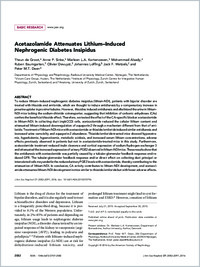Acetazolamide Attenuates Lithium-Induced Nephrogenic Diabetes Insipidus.
- de Groot T Departments of Physiology and.
- Sinke AP Departments of Physiology and.
- Kortenoeven ML Departments of Physiology and.
- Alsady M Departments of Physiology and.
- Baumgarten R Vivium Care Group, Huizen, The Netherlands;
- Devuyst O Institute of Physiology, Zurich Centre for Integrative Human Physiology, Zurich, Switzerland; and.
- Loffing J Anatomy, University of Zurich, Zurich, Switzerland.
- Wetzels JF Nephrology, Radboud University Medical Center, Nijmegen, The Netherlands;
- Deen PM Departments of Physiology and peter.deen@Radboudumc.nl.
- 2015-11-18
Published in:
- Journal of the American Society of Nephrology : JASN. - 2016
cell and transport physiology
diabetes insipidus
diuretics
osmolality
pathophysiology of renal disease and progression
water transport
Acetazolamide
Amiloride
Animals
Aquaporin 2
Diabetes Insipidus, Nephrogenic
Diuretics
Female
Lithium Compounds
Mice
Mice, Inbred C57BL
Sodium Chloride Symporter Inhibitors
English
To reduce lithium-induced nephrogenic diabetes insipidus (lithium-NDI), patients with bipolar disorder are treated with thiazide and amiloride, which are thought to induce antidiuresis by a compensatory increase in prourine uptake in proximal tubules. However, thiazides induced antidiuresis and alkalinized the urine in lithium-NDI mice lacking the sodium-chloride cotransporter, suggesting that inhibition of carbonic anhydrases (CAs) confers the beneficial thiazide effect. Therefore, we tested the effect of the CA-specific blocker acetazolamide in lithium-NDI. In collecting duct (mpkCCD) cells, acetazolamide reduced the cellular lithium content and attenuated lithium-induced downregulation of aquaporin-2 through a mechanism different from that of amiloride. Treatment of lithium-NDI mice with acetazolamide or thiazide/amiloride induced similar antidiuresis and increased urine osmolality and aquaporin-2 abundance. Thiazide/amiloride-treated mice showed hyponatremia, hyperkalemia, hypercalcemia, metabolic acidosis, and increased serum lithium concentrations, adverse effects previously observed in patients but not in acetazolamide-treated mice in this study. Furthermore, acetazolamide treatment reduced inulin clearance and cortical expression of sodium/hydrogen exchanger 3 and attenuated the increased expression of urinary PGE2 observed in lithium-NDI mice. These results show that the antidiuresis with acetazolamide was partially caused by a tubular-glomerular feedback response and reduced GFR. The tubular-glomerular feedback response and/or direct effect on collecting duct principal or intercalated cells may underlie the reduced urinary PGE2 levels with acetazolamide, thereby contributing to the attenuation of lithium-NDI. In conclusion, CA activity contributes to lithium-NDI development, and acetazolamide attenuates lithium-NDI development in mice similar to thiazide/amiloride but with fewer adverse effects.
- Language
-
- English
- Open access status
- bronze
- Identifiers
-
- DOI 10.1681/ASN.2015070796
- PMID 26574046
- Persistent URL
- https://folia.unifr.ch/global/documents/211895
Statistics
Document views: 32
File downloads:
- fulltext.pdf: 0
